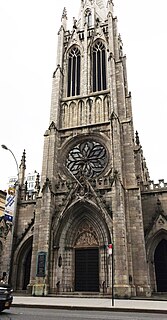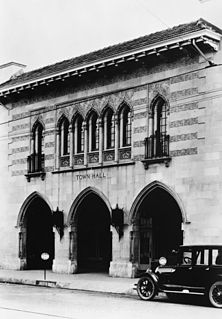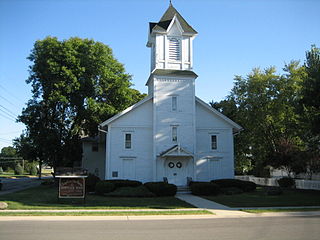
The buildings and architecture of Chicago reflect the city's history and multicultural heritage, featuring prominent buildings in a variety of styles. Most structures downtown were destroyed by the Great Chicago Fire in 1871.
The Meadville Lombard Theological School is a Unitarian Universalist seminary in Chicago, Illinois.

Grace Church is a historic parish church in Manhattan, New York City which is part of the Episcopal Diocese of New York. The church is located at 800–804 Broadway, at the corner of East 10th Street, where Broadway bends to the south-southeast, bringing it in alignment with the avenues in Manhattan's grid. Grace Church School and the church houses—which are now used by the school—are located to the east at 86–98 Fourth Avenue between East 10th and 12th Streets.

Jules Jacques Benois Benedict was one of the most prominent architects in Colorado history, whose works include a number of well-known landmarks and buildings listed on the National Register of Historic Places.

First Baptist Congregational Church is a United Church of Christ and Baptist congregation currently located at 60 N. Ashland Blvd. in Chicago, Illinois, United States. The church building is an Illinois Historic Landmark and is listed on the National Register of Historic Places. The building was designed by architect Gurdon P. Randall for the Union Park Congregational Church, founded in 1860, and was built between 1869 and 1871. After the Great Chicago Fire of 1871, the Mayor's Office, City Council, and General Relief Committee of Chicago were temporarily headquartered in the church. In 1910, the building of nearby First Congregational Church burnt down. Union Park Congregational then merged with First Congregational to form (New) First Congregational Church. Two other congregations would eventually merge into the new First Congregational Church: Leavitt Street Congregational Church in 1917 and Bethany Congregational Church in the 1920s.
Minard Lafever (1798–1854) was an American architect of churches and houses in the United States in the early nineteenth century.
Sidney Rose Badgley was a prominent start-of-the-20th-century Canadian-born architect. He was active throughout the United States and Canada, with a significant body of work in Cleveland.

Seton Hill Historic District is a historic district in Baltimore, Maryland. It was listed on the National Register of Historic Places in 1975.

Emmanuel Baptist Church is a Baptist megachurch in the Clinton Hill neighborhood of Brooklyn, New York, on the northwest corner of Lafayette Avenue and St. James Place, affiliated with the American Baptist Churches USA. The attendance is 2,200 peoples. The senior pastor is Anthony L. Trufant.

Edward Townsend Mix was an American architect of the Gilded Age who designed many buildings in the Midwestern United States. His career was centered in Milwaukee, Wisconsin, and many of his designs made use of the region's distinctive Cream City brick.

The South Congregational Church is a historic church at 90 Main Street in New Britain, Connecticut. It is a large brownstone Gothic Revival structure, located at a central intersection in the city's heart. The church was built in 1865, with the parish house added in 1889. Both were designed by the noted Boston architect George F. Meacham. The congregation was established in 1842, and was merged with a local Baptist congregation in 1974. The building was listed on the National Register of Historic Places in 1990.

Stephen Carpenter Earle was an architect who designed a number of buildings in Massachusetts and Connecticut that were built in the late 19th century, with many in Worcester, Massachusetts. He trained in the office of Calvert Vaux in New York City. He worked for a time in partnership with James E. Fuller, under the firm "Earle & Fuller". In 1891, he formed a partnership with Vermont architect Clellan W. Fisher under the name "Earle & Fisher".

John Tarring FRIBA (1806–1875) was an English Victorian ecclesiastical architect active in the mid-nineteenth century. Based in London, he designed many Gothic Revival churches for Nonconformist clients.

The Dundee Township Historic District is a set of sixty-five buildings in Dundee Township, Kane County Illinois. Buildings in the district are found in East Dundee, West Dundee, and Carpentersville. The district represents the development of the upper Fox River Valley from 1870 to the 1920s. Dundee Township became an important industrial area, especially following the construction of the Dundee Brick Company in West Dundee and the Illinois Iron and Bolt Company in Carpentersville. Also included in the district are a variety of Queen Anne, Italianate, and Greek Revival style houses and Gothic Revival churches. The majority of the historic district lies within the boundaries of West Dundee. It was added to the National Register of Historic Places in 1975.

Congregational United Church of Christ is located in the downtown area of Iowa City, Iowa, United States near the campus of the University of Iowa. The congregation was organized in 1856 and the church building was listed on the National Register of Historic Places in 1973. In 2004 it was included as a contributing property in the Jefferson Street Historic District.

Allen & Collens was an architectural partnership between Francis Richmond Allen and Charles Collens that was active from 1904 to 1931. Allen had previously worked in the Boston-based partnerships Allen & Kenway (1878–91) and Allen & Vance (1896–98), which executed Lathrop House (1901) and Davison House (1902) at Vassar College. The firm was known for its Gothic Revival design work.
Patton & Fisher was an architectural firm in Chicago, Illinois. It operated under that name from 1885 to 1899 and later operated under the names Patton, Fisher & Miller (1899–1901) and Patton & Miller (1901–1915). Several of its works are listed on the National Register of Historic Places.

Gurdon P. Randall was an architect in Chicago, Illinois. Early in his career, he studied in Boston, Massachusetts, in the office of Asher Benjamin. He moved to Chicago when he was 30, and practiced there for 34 years, focusing on large institutional architecture. He designed a number of notable buildings, including several that survive and are listed on the National Register of Historic Places.

The architecture of Jacksonville is a combination of historic and modern styles reflecting the city's early position as a regional center of business. According to the National Trust for Historic Preservation, there are more buildings built before 1967 in Jacksonville than any other city in Florida, but it is also important to note that few structures in the city center predate the Great Fire of 1901. Numerous buildings in the city have held state height records, dating as far back as 1902, and last holding a record in 1981.

Bristol Congregational Church, also known as the Chapel on the Green, is a historic church located at 107 W. Center Street in Yorkville, Illinois. The Congregational church was built in 1855 for a congregation which formed in the 1830s. The church's design came from a pattern book and includes elements of both the Greek Revival and Carpenter Gothic styles. The church's structure, which includes a bell tower, pediment, and symmetrical windows, is typical of Greek Revival churches. Its Carpenter Gothic elements are mainly decorative and include ornamental wooden trim and a finial. The church is the only remaining 19th-century church in Yorkville and its oldest non-residential building of any sort.



















